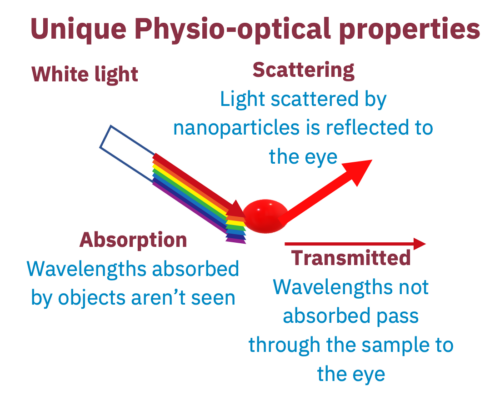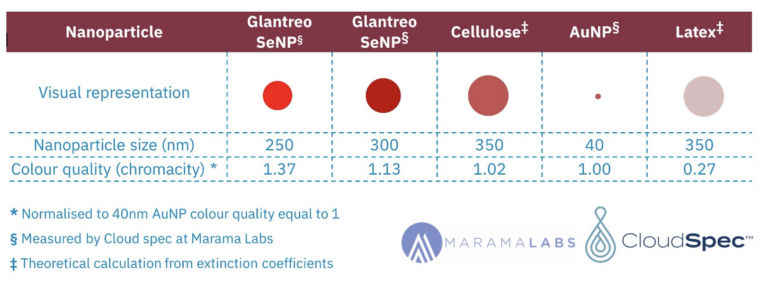Glantreo collaborate with Marama Labs to quantify brightness of Selenium Nanoparticles
Selenium Nanoparticles (SeNP) for lateral flow assays
The bright red colour of large selenium colloid solutions makes them ideal for use as staining reagents to label low concentrations targets in immunoassays. Glantreo’s Selenium nanoparticles (SeNP) offer an alternative to gold nanoparticles (AuNP) lateral flow antigen (LFA) tests.
Brighter particles – more sensitive assays
Glantreo’s Selenium Nanoparticles (SeNP) combine large surface area with high colour quality to create a more visible particle, producing a visible line at low concentrations of antigens, for a more sensitive lateral flow assay. Marama Labs CloudSpecTM device was able to determine Glantreo SeNP were up to 37% more visible than industry standard 40nm AuNP.

When white light hits an object, how wavelengths interact determines the colour seen. A simplified way of measuring and describing the visibility of a solution is by measuring its Extinction optical density (OD) by UV-Vis. Extinction OD is a sum of the spectra for light absorbed and scattered by an object. However, unlike smaller nanoparticles where colour is mostly governed by wavelengths absorbed, a considerable amount of the Extinction OD of large SeNP comes from scattered light, which makes it difficult to measure the colour that can be seen by eye. To analyse the chromacity, and therefore colour quality of our SeNP, we used a MaramaLabs CloudSpecTM device to quantify the spectral components of our nanoparticles.
Method
The optical properties of Glantreo’s SeNP were evaluated using the CloudSpecTM UV-Vis from MaramaLabs (New Zealand). This instrument uses an integrating sphere to measure both extinction and absorption spectra of samples, producing results in optical density normalized to a path length of 1 cm. The scattering spectrum can, therefore, be deduced from the difference between extinction and absorption spectra.

Results
CloudSpecTM analysis shows SeNP have a stronger per-particle absorbance than AuNP, which increases with decreasing particle size, making SeNP more visible at lower concentrations. Furthermore, the unique scattering spectra indicate the presence of strong >600nm optical resonances, which create opportunities for more sensitive device configurations. Due to the strength of the scattering contributions to the visibility of these particles, determining the absorbance spectrum from a more traditional, extinction-only spectrophotometer would not have been possible. Representations of the differences in colour and size of different nanoparticles are shown below:

SeNP for LFA – Advantages
A pdf version is available for Print/Download
Want to know more about our SeNP Products
Go to the Product Page.
